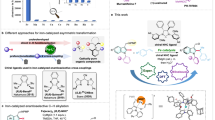Abstract
An efficient and convenient strategy for synthesis of enantiomerically pure S-2-(1-hydroxy-3-butenyl)-5-methylfuran was for the first time described utilizing a lipase-mediated asymmetric acylation in organic solvents. Rhizopus arrhizus lipase was chosen as the biocatalyst, and different immobilization methods including sol–gel encapsulation and covalent attachment were adopted to improve its catalytic characteristics. Various influential factors of the reaction were also investigated. Finally, the results showed that the lipase covalently attached onto epoxy resin exhibited the highest enantioselectivity and operational stability. Under optimized reaction conditions, i.e., n-hexane as the solvent, 5/1 (mol/mol) of vinyl acetate to 2-(1-hydroxy-3-butenyl)-5-methylfuran and 30 °C, the ee value of S-1 reached up to above 98% at 52% conversion with an E value of 99.


Similar content being viewed by others
References
Bastida A, Sabuquillo P, Armisen P, Fernandez-Lafuente R, Huguet J, Guisan JM (1998) A single step purification, immobilization, and hyperactivation of lipases via interfacial adsorption on strongly hydrophobic supports. Biotechnol Bioeng 58:486–493
Bierstedt A, Stölting J, Fröhlich R, Metz P (2001) Enzymatic kinetic resolution of 1-(3’-furyl)-3-buten-1-ol and 2-(2’-furyl)-propan-1-ol. Tetrahedron: Asymmetry 12:3399–3407
Brzozowski AM, Derewenda U, Derewenda ZS, Dodson GG, Lawson DM, Turkenburg JP, Bjorkling F, Huge-Jensen B, Patkar SA, Thim L (1991) A model for interfacial activation in lipases from the structure of a fungal lipase-inhibitor complex. Nature 351:491–494
Carrea G, Ottolina G, Riva S (1995) Role of solvents in the control of enzyme selectivity in organic media. Trends Biotechnol 13:63–70
Chang C-S, Wu P-L (2007) Synthesis of triglycerides of phenylalkanoic acids by lipase-catalyzed esterification in a solvent-free system. J Biotechnol 127:694–702
Chaubey A, Parshad R, Koul S, Taneja SC, Qazi GN (2006) Arthrobacter sp. lipase immobilization for improvement in stability and enantioselectivity. Appl Microbiol Biotechnol 73:598–606
Chen CS, Fujimoto Y, Girdaukas G, Sih CJ (1982) Quantitative analyses of biochemical kinetic resolutions of enantiomers. J Am Chem Soc 104:7294–7299
Davranov K (1994) Microbial lipases in biotechnology. Appl Biochem Microbiol 30:527–534
Fernandez-Lorente G, Terreni M, Mateo C, Bastida A, Fernandez-Lafuente R, Dalmases P (2001) Modulation of lipase properties in macroaqueous system by controlled enzyme immobilization: enantioselective hydrolysis of a chiral ester by immobilized Pseudomonas lipase. Enzyme Microb Technol 28:389–396
Ghanem A, Aboul-Enein HY (2005) Application of lipases in kinetic resolution of racemates. Chirality 17:1–15
Gill I, Ballesteros A (2000) Bioencapsulation within synthetic polymers (Part 1): sol–gel encapsulated biologicals. Trends Biotechnol 18:282–296
Gómez JM, Romero MD, Fernández TM (2005) Immobilization of β-Glucosidase on carbon nanotubes. Catal Lett 101:275–278
Grazú V, Abian O, Mateo C, Batista-Viera F, Fernandez-Lafuente R, Guisan JM (2005) Stabilization of enzymes by multipoint immobilization of thiolated proteins on new epoxy-thiol supports. Biotechnol Bioeng 90:597–605
Holmberg P, Karlsson J, Gogoll A (2005) Enzymatic kinetic resolution of 1-(3-furyl)-3-buten-1-ol. Tetrahedron: Asymmetry 16:2397–2399
Jaeger K-E, Reetz MT (1998) Microbial lipases form versatile tools for biotechnology. Trends Biotechnol 16:396–403
Kazlauskas RJ, Weisfloch ANE, Rappaport AT, Cuccia LA (1991) A rule to predict which enantiomer of a secondary alcohol reacts faster in reactions catalyzed by cholesterolesterase, lipase from Pseudomonas cepacia, and lipase from Candida rugosa. J Org Chem 56:2656–2665
Kazuo T, Kunihiko T (1988) Production of furfuryl alcohols. Patent No. JP63030480A
Klibanov AM (1997) Why are enzymes less active in organic solvents than in water? Trends Biotechnol 15:97–101
Kwiatkowski P, Chaladaj W, Jurczak J (2006) Catalytic asymmetric allylation of aldehydes using the chiral (salen)chromium(III) complexes. Tetrahedron 62:5116–5125
Loh TP, Zhou JR (2000) A catalytic enantioselective allylation reaction of aldehydes in an aqueous medium. Tetrahedron Lett 41:5261–5264
Lu J, Ji SJ, Loh TP (2005) Enantioselective allylation of aldehydes catalyzed by chiral indium(III) complexes immobilized in ionic liquids. Chem Commun 18:2345–2347
Miyazawa T, Houhashi M, Inoue Y, Murashima T, Yamada T (2008) Resolution of secondary alcohols via Carica papaya lipase-catalyzed enantioselective acylation. Biotechnol Lett 30:1783–1787
Palomo JM, Fernández-Lorente G, Mateo C, Fuentes M, Fernández-Lafuente R, Guisan JM (2002a) Modulation of the enantioselectivity of Candida antarctica B lipase via conformational engineering. Kinetic resolution of (±)-α-hydroxy-phenylacetic acid derivatives. Tetrahedron: Asymmetry 13:1337–1345
Palomo JM, Fernández-Lorente G, Mateo C, Ortiz C, Fernandez-Lafuente R, Guisan JM (2002b) Modulation of the enantioselectivity of lipases via controlled immobilization and medium engineering: hydrolytic resolution of mandelic acid esters. Enzyme Microb Technol 31:775–783
Parida S, Dordick JS (1991) Substrate Structure and Solvent Hydrophobicity Control Lipase Catalysis and Enantioselectivity in Organic Media. J. Am. Chem. Soc. 113:2253–2259
Reetz MT, Zonta A, Simpelkamp J (1996) Efficient immobilization of lipases by entrapment in hydrophobic sol–gel materials. Biotechnol Bioeng 49:527–534
Secundo F, Riva S, Carrea G (1992) Effects of medium and of reaction conditions on the enantioselectivity of lipases in organic solvents and possible rationales. Tetrahedron: Asymmetry 3:267–280
Varma R, Sangita MK, Sanjay N, Uttam RK (2008) Lipases catalyzed enantioselective hydrolysis of (R,S)-methyl 1,4-benzodioxan-2-carboxylate intermediate for (S)-doxazosin mesylate. World J Microbiol Biotechnol 24:577–579
Vosmann K, Wiege B, Weitkamp P, Weber N (2008) Preparation of lipophilic alkyl(hydroxy)benzoates by solvent-free lipase-catalyzed esterification and transesterification. Appl Microbiol Biotechnol 80:29–36
Weitkamp P, Vosmann K, Weber N (2006) Highly efficient preparation of lipophilic hydroxycinnamates by solvent-free lipase-catalyzed transesterification. J Agric Food Chem 54:7062–7068
Wu XM, Sun W, Xin JY, Xia CG (2008) Lipase-catalysed kinetic resolution of secondary alcohols with improved enantioselectivity in propylene carbonate. World J Microbiol Biotechnol, in press
Acknowledgements
The authors would like to thank the Chinese National Natural Science Foundation (No. 20606030 and 20336010), Key Project of Chinese National Programs for Fundamental Research and Development (No. 2003CB716008) and Hi-Tech Research and Development Program of China (No. 2006AA02Z238) for financial support.
Author information
Authors and Affiliations
Corresponding author
Rights and permissions
About this article
Cite this article
Yang, G., Wu, J., Xu, G. et al. Enantioselective resolution of 2-(1-hydroxy-3-butenyl)-5-methylfuran by immobilized lipase. Appl Microbiol Biotechnol 81, 847–853 (2009). https://doi.org/10.1007/s00253-008-1713-x
Received:
Revised:
Accepted:
Published:
Issue Date:
DOI: https://doi.org/10.1007/s00253-008-1713-x




